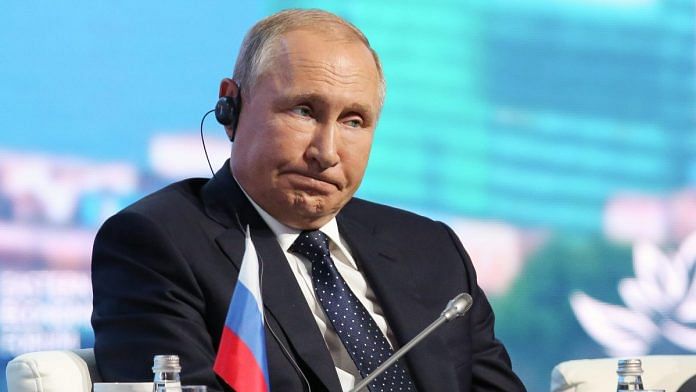President Vladimir Putin nailed the prototypical Davos leader address this week. He started with a little light chat about first meeting his host, the World Economic Forum’s smooth-talking Klaus Schwab, segued into remarks on the challenges of virtual communication, a little hand-wringing about global challenges, and then his favorite themes remixed into a reassuringly vague address.
So far, so normal. But context is everything.
Putin addressed the WEF on Wednesday after a weekend when many tens of thousands of Russians took to the streets across the country, with thousands of them later arrested. A significant portion of participants were protesting for the first time. Many marched in support of Kremlin critic Alexey Navalny, poisoned last year and now in jail. But they also demonstrated in frustration with an increasingly socially conservative government, a stagnating economy and social injustice — sentiments fanned by a film released online by Navalny about Putin’s finances and ties to an opulent seaside mansion. The Kremlin denies any links.
None of that merited a mention when addressing the global elite. The closest he came was a swipe at the power of technology companies, whose social media apps have been used to organize and broadcast the gatherings.
The Russian president isn’t alone in taking advantage of the theater that is Davos, where high-minded speeches are often distant from reality. His address came two days after China’s Xi Jinping used the same non-threatening environment to effusively call for collaboration and rail against global bullies, shortly after sending fighter planes into the Taiwan Strait.
Still, with fresh marches planned across Russia on Sunday and more expected after that, Putin’s decision to make his first appearance at the WEF in over a decade — possibly at the last minute, given he wasn’t on the pre-conference agenda — matters. It’s an eloquent expression of just how the Kremlin is struggling to respond to the brewing crisis. A turn on the world stage is a reliable last resort when it comes to reminding audiences at home, and indeed abroad, of who is still Russia’s respected elder statesman.
Also read: Navalny stands alone in his epic battle with Putin
Putin’s Davos speech
It wasn’t his first public comment. Putin took the highly unusual step on Monday of using a scripted question-and-answer session with students to address the demonstrations, recognizing the discontent but showing a poor grasp of the public mood. The protests, he intimated, would lead to chaos similar to the upheaval seen in the 1990s after the fall of the Soviet Union — a contrast popular with a president who promises order and stability. This, he told the young group, is just not how politics is done.
At virtual Davos, he took a different tack. Much there was a riff on Putin’s favorite themes when addressing international crowds. There was the threat of destabilization, polarization and veiled references to the insurrection in Washington, pointing to radicalism and strained political processes “even in leading nations.” On a larger canvas, he drew parallels with the 1930s, when failure to resolve international tensions sparked World War II, and called for new order allowing space for “different development centers with their distinctive models.”
He dwelled on inequality and social divisions, but without real solutions. It rang hollow for the leader of a country that has hardly been exemplary in spreading around wealth, not least by being comparably frugal in its Covid-19 support to households.
Finally, and most telling, he took aim at technology outfits. They are competing with states, he complained, dipping into the global antitrust debate. For Russian consumers, at least, there are homegrown alternatives to the likes of Amazon and Google. This said far more about a frustration with an inability to muzzle the online public square, where, unlike with state media, the Kremlin has no monopoly over the conversation, and lacks Navalny’s savvy fluency with which to fight back.
Social media apps like TikTok and YouTube, plus Russian alternatives like VKontakte, played a fundamental role in last weekend’s events. On Saturday, according to Navalny’s organization, 5,000 people were on the street in the Siberian city of Omsk — but 500,000 people watched the live stream of the same protest.
That matters because what happens next in Russia will depend on how long opposition leaders can keep crowds mobilized and whether they can translate the support into real disruption at the ballot box come September’s parliamentary elections. It will require some staying power and plenty of online visibility.
Numbers are not everything, though. The Kremlin has, predictably, played up the small size of Navalny’s demonstrations as compared with how many people vote for the president. A particularly unsettling pro-Putin attempt to counter critics’ viral success was a video of scores of workers dancing and shouting support in unison. Yet in the context of the harassment, arrests and pressure from even private employers and educational institutions to steer clear of the protests, even small numbers speak volumes. Under such conditions, the risk-taking and sacrifice of a few can resonate widely and crackdowns can backfire.
Efforts so far to calm the discontent have displayed the tin ear of authorities unused to listening. — Bloomberg
Also read: Poisoning, arrest and a ‘billion-dollar palace’ fire up Russians



